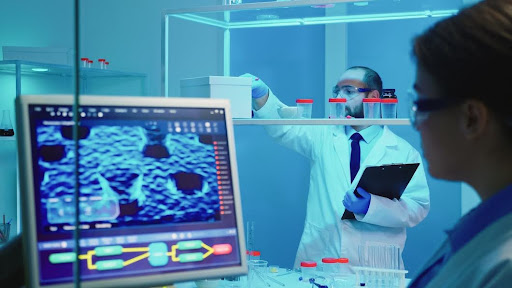Reimagining GI Cancer Detection: Emerging Testing Strategies
Medical advances and emerging technologies constantly shape the field of cancer detection. Early diagnosis can significantly improve patient outcomes in the case of gastrointestinal (GI) cancer. With this in mind, medical researchers and professionals are reimagining GI cancer detection by developing innovative testing strategies.
This article delves into the latest trends and advancements in GI cancer detection, showcasing their potential impact on patient care. From noninvasive screening options to cutting-edge molecular and genetic testing techniques, the article explores how these strategies can enhance early detection, improve accuracy, and potentially lead to more personalized treatment plans.
Whether incorporating liquid biopsies, using Next-Generation Sequencing (NGS) technologies, or integrating artificial intelligence in data analysis, this article will highlight the evolving landscape of GI cancer detection and the potential benefits for patients and healthcare providers. Join us as we explore the future of GI cancer detection and how these emerging testing strategies may revolutionize cancer care.
The Importance Of Early Detection In GI Cancer
Early detection plays a crucial role in the successful treatment of GI cancer. Diagnosing early increases the chances of successful treatment and long-term survival. Traditional testing strategies for GI cancer, such as endoscopies and imaging techniques, have been adequate to some extent. However, they often rely on visible symptoms or the presence of tumors, limiting their ability to detect cancer in its early stages. This is particularly concerning as GI cancers are often asymptomatic until they reach an advanced stage, making early detection challenging.
To overcome these limitations, medical professionals are actively exploring new testing strategies to detect GI cancer at its earliest stages. Patients can receive timely interventions and improve their chances of successful treatment outcomes by identifying cancer cells or genetic mutations before visible symptoms arise. These emerging testing strategies offer hope for more effective and accurate detection methods.
Traditional Testing Strategies For GI Cancer
Historically, traditional testing strategies for GI cancer have relied on invasive procedures such as endoscopies, colonoscopies, and biopsies. These methods involve physically examining the gastrointestinal tract or removing tissue samples for analysis. While these techniques have been the gold standard for many years, they have limitations that can hinder early detection.
Endoscopies and colonoscopies, for example, are invasive procedures that can be uncomfortable for patients and carry a small risk of complications. Additionally, these procedures can only detect visible tumors or abnormalities to the naked eye, potentially missing smaller or precancerous lesions. Similarly, biopsies require a tissue sample to be obtained, which may only sometimes be feasible depending on the location of the cancerous lesion.
Emerging Testing Strategies For GI Cancer
Advancements in technology and research have paved the way for emerging testing strategies that offer promising alternatives to traditional methods. These strategies aim to improve early detection rates, enhance accuracy, and provide more personalized treatment options for patients.
Liquid Biopsy: A Game-Changer In GI Cancer Detection
Liquid biopsies are noninvasive tests that utilize a blood sample to detect cancer-related genetic mutations or alterations. These tests have gained significant attention in recent years for their potential to revolutionize cancer detection. In the case of GI cancer, liquid biopsies can detect circulating tumor DNA (ctDNA) or tumor-derived RNA in the bloodstream, providing valuable insights into the presence and progression of the disease.
The advantages of liquid biopsies are numerous. They offer a less invasive alternative to traditional biopsies, making them more accessible and acceptable to patients. Liquid biopsies can also be performed more frequently, allowing for regular monitoring of disease progression or treatment response. Additionally, these tests have the potential to detect cancer at an earlier stage, even before symptoms manifest, improving the chances of successful treatment.
Integrating OncoTrace for Enhanced Insights
RGCC’s OncoTrace test stands out as a game-changer in liquid biopsy testing, offering comprehensive insights into cancer progression and prognosis. By assessing circulating tumor cell (CTC) count, phenotype markers, and stemness markers in the bloodstream, OncoTrace provides invaluable information that goes beyond conventional liquid biopsy approaches.
The OncoTrace test’s CTC count assessment directly indicates treatment efficacy, guiding therapeutic decisions based on changes in cancer cell presence. Furthermore, the evaluation of phenotype markers sheds light on the tissue origins of cancer cells, aiding in diagnosis and disease monitoring. Most importantly, analyzing stemness markers offers critical insights into cancer cell behavior and activity levels, enabling informed decisions regarding treatment continuation and cancer-free survival.
By incorporating OncoTrace into liquid biopsy testing protocols, healthcare professionals can leverage a comprehensive approach to GI cancer detection and monitoring, enhancing personalized treatment strategies and improving patient outcomes.
Next-Generation Sequencing In GI Cancer Testing
Next-generation sequencing (NGS) technologies have revolutionized the field of genetic testing. These techniques enable the simultaneous analysis of multiple genes, providing a comprehensive understanding of the genetic alterations associated with GI cancer. By sequencing the entire genome or specific gene panels, NGS can identify mutations, gene fusions, and other genetic abnormalities that contribute to the development and progression of GI cancer.
NGS enhances the accuracy of cancer diagnosis and helps guide treatment decisions. By identifying specific genetic alterations, healthcare providers can select targeted therapies more likely to be effective for individual patients. Additionally, NGS can identify genetic markers associated with drug resistance, enabling healthcare providers to adjust treatment plans accordingly and maximize the chances of successful outcomes.
The Role Of AI and Machine Learning In GI Cancer Detection
Artificial intelligence (AI) and machine learning algorithms are increasingly integrated into various healthcare aspects, including cancer detection. In GI cancer, AI can play a significant role in analyzing vast amounts of complex data, identifying patterns, and assisting in early cancer detection.
AI algorithms can analyze medical images, such as endoscopy or imaging scans, with high accuracy, helping healthcare providers identify suspicious lesions or abnormalities. By comparing these images to a vast database of known cases, AI can assist in the early identification of potential cancerous lesions, even those that the human eye may miss. AI can also aid in the interpretation of genetic testing results, identifying relevant mutations or predictive markers that can inform treatment decisions.
Challenges And Future Directions In GI Cancer Testing
While emerging testing strategies show great promise in the early detection of GI cancer, challenges still need to be addressed. One significant challenge is the cost and accessibility of these innovative tests. As with any new technology, the initial costs can be prohibitive for widespread implementation. However, as these strategies become more established and widely adopted, the costs are expected to decrease, making them more accessible to patients and healthcare providers.
Another challenge is interpreting and integrating the vast amount of data generated by these tests. Liquid biopsies and NGS technologies produce large datasets that require sophisticated data analysis algorithms. Additionally, integrating AI and machine learning algorithms into clinical practice requires careful validation and regulatory approval to ensure patient safety and accuracy.
Conclusion: The Promising Future Of GI Cancer Detection
The future of GI cancer detection looks promising with the emergence of innovative testing strategies. Liquid biopsies, Next-Generation Sequencing (NGS) technologies, and the integration of AI and machine learning algorithms are revolutionizing the field, offering more accurate, accessible, and personalized approaches to early detection.
These emerging strategies can potentially transform patients’ lives by enabling timely interventions, improving treatment outcomes, and ultimately saving lives. As research and technology continue to advance, healthcare providers, researchers, and policymakers must collaborate, overcome challenges, and ensure the widespread adoption of these innovative testing strategies. By doing so, we can reimagine GI cancer detection and enhance patient care in the fight against this devastating disease.



